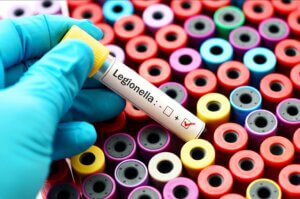I have a positive Legionella count – What do I do?
First of all, don’t panic.
Getting a positive Legionella test in your domestic water system is not news any facility wants to hear, however as anyone with involvement in water knows, the likelihood of Legionella bacteria being present within domestic (or other) water systems, typically comes as no surprise.
A positive test result for the bacteria isn’t necessarily a sign of non-compliance, legionella bacteria is present in almost all natural water sources, and it is only certain conditions in man-made water systems that encourage growth and lead to risk. As such, the focus of Legionella risk management should be on preventing this known and hazardous bacteria from multiplying in water systems rather than reacting to a problematic situation.
However, the presence of a confirmed positive Legionella count [or counts] does strike fear into all the those who have an involvement with water safety and it’s important to know what to do in the event of a positive result.
Whether the positive count is warranted or could have been avoided is a moot point, and action must then be taken to investigate and resolve the root cause in the immediate and longer terms.

Don’t panic, but take it seriously
A positive test is distressing information, but the good news is that you’re aware of this early on exactly because you implemented testing for Legionella (proactive testing is the most important thing you can do to protect the people around you).
The growth of legionella bacteria in a water system can lead to a risk of people contracting Legionnaires’ disease. This is a serious form of pneumonia that can have fatal consequences, as well as severe financial and legal repercussions for an organisation responsible for an outbreak.
Your immediate priorities following a positive test result for legionella bacteria on-site should be to Take action to protect the health and safety of the people in your care (staff, residents, visitors, etc);
Typically, any distal site positivity rate above 30% means that the people in your building could be at risk of contracting Legionnaire’s Disease. For example, if water from ten locations in your building is collected and tested, and more than three of those locations come back positive, that is considered a higher than 30% positivity rate.
Steps to take
The HSE’s Legionnaires’ disease Technical guidance Part 2 recommends that if the minority of results are returned with between 100 and 1000 colony-forming units per litre (CFU/l), the system should initially be resampled.
If it is still positive, then an assessment needs to be carried out to identify remedial actions, and a review of your control measures must be undertaken.
If the majority of the first sample results are between 100 and 1000 CFU/l, you will immediately need to review control measures and undertake a risk assessment to identify remedial action, including disinfecting the system.
If your sample has more than 1000 CFU/l, then you must resample the system and undertake an immediate review of control measures, as well as do a risk assessment to identify remedial action, including possible disinfection.
Retesting needs to take place a few days after disinfection and at frequent intervals subsequently until control is achieved.
If you are in charge of a facility with vulnerable patients, you will need to investigate and resample water showing detection of legionella under 100 CFU/l, with all the subsequent measures detailed above.

Remedial Works
After a positive test you will possibly need to undertake corrective measures, these could include:
Installing point-of-use filters at any location in your facility where water exits the system. This means attaching a filter between the water system and the point of exit. For faucets and shower heads, for example, maintenance personnel must remove aerators and attach filters.
Shock disinfection using Sanosil Super 25. Sanosil solution is pumped directly into the contaminated systems and then flushed through the whole system, after 4 hours this can be washed out and flushed through the outlets and retested.
Dead Leg removal, if there are redundant pipes, they can be removed completely. Alternatively, the water system may have to be redesigned in order to discourage stagnation, and other preventative measures carried out such as limescale removal, servicing mixing valves or insulating pipework. Or it could be something as simple as installing a new lid on your water tank.
Update Records
It is essential that you document all findings of the risk assessment, tests and remedial action undertaken. This not only ensures an adequate paper trail for auditors to know you’ve dealt with the issue in a satisfactory manner, it also helps new staff see what’s been done previously and what they need to continue to do to ensure future legionella compliance.
Records should be kept for the duration of the time for which they remain current and for at least two years after that. However, records detailing the monitoring inspections, tests and dates need to be kept for at least five years.
Conclusion
Positive Legionella counts are certainly a cause for concern, and the elimination of limited or extensive Legionella contamination is not likely to be easy, or by way of simple/individual measures such as chemical chlorination.
That said, current guidance is straightforward and helpful and in addition to achievable action plans, a well thought through Written Scheme/Water Safety Plan and reliable advice from your water treatment consultants will contribute to elimination of positive Legionella samples.






